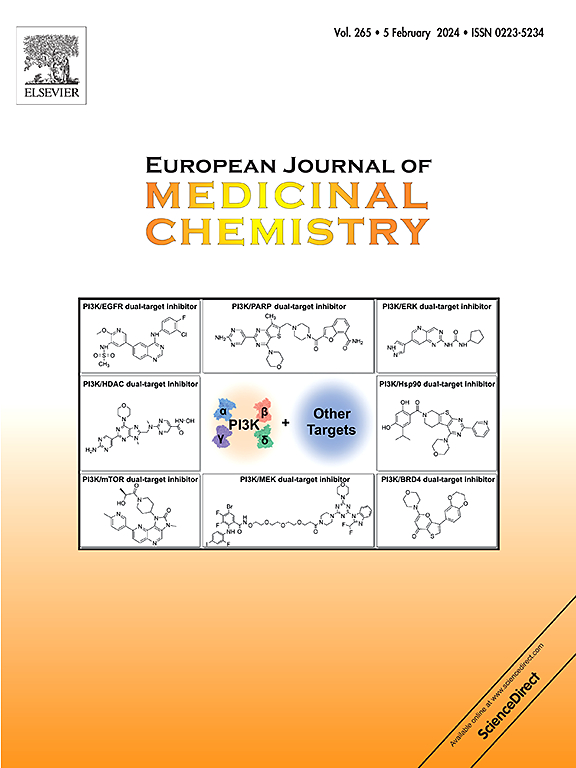A novel 20 (R) dammarane panaxadiol- indole-2 ',3' -dione derivative was found to inhibit the growth and migration of colorectal cancer cells by inhibiting EGFR-mediated RalA/EMT pathway
IF 6
2区 医学
Q1 CHEMISTRY, MEDICINAL
引用次数: 0
Abstract
Panaxadiol (PD) is a secondary metabolite of ginsenosides and has excellent anti-tumor activity. In this study, by coupling PD with the anti-tumor active fragment 1H-indole-2, 3-dione, 24 novel PD derivatives were designed and synthesized to enhance their anti-tumor efficacy and tumor selectivity. Among them, the proliferation inhibition rate of compound 4e on colorectal cancer cells (IC50=4.46 ± 0.70 μM) was 16.92 times lower than that of HEK293, showing a relatively high therapeutic window. Mechanologically, compound 4e inhibits CDKs activity, induces G0/G1 cycle arrest, reduces mitochondrial membrane potential and ROS activity, induces apoptosis, and inhibits migration and invasion. It is worth noting that for the first time, we discovered that compound 4e regulates the RalA/EMT pathway by inhibiting EGFR rather than RalB, disrupts the formation of filamentate feet and cytoskeletal remodeling, and interferes with the migration and growth of colorectal cancer cells. In vivo experiments further confirmed that compound 4e has higher anti-tumor activity and safety than 5-fluorouracil. Overall, we reported 4e as a promising candidate for the treatment of colorectal cancer.

一种新的20 (R)达玛烷panaxadiol-吲哚-2 ',3' -二酮衍生物通过抑制egfr介导的RalA/EMT途径抑制结直肠癌细胞的生长和迁移
Panaxadiol (PD)是人参皂苷的次级代谢产物,具有良好的抗肿瘤活性。本研究通过将PD与抗肿瘤活性片段1h -吲哚- 2,3 -二酮偶联,设计合成了24种新型PD衍生物,以增强其抗肿瘤功效和肿瘤选择性。其中,化合物4e对结直肠癌细胞的增殖抑制率(IC50=4.46±0.70 μM)比HEK293低16.92倍,显示出较高的治疗窗口期。机制上,化合物4e抑制CDKs活性,诱导G0/G1周期阻滞,降低线粒体膜电位和ROS活性,诱导细胞凋亡,抑制迁移和侵袭。值得注意的是,我们首次发现化合物4e通过抑制EGFR而非RalB调控RalA/EMT通路,破坏丝状足的形成和细胞骨架重塑,干扰结直肠癌细胞的迁移和生长。体内实验进一步证实化合物4e比5-氟尿嘧啶具有更高的抗肿瘤活性和安全性。总的来说,我们报道了4e作为治疗结直肠癌的有希望的候选药物。
本文章由计算机程序翻译,如有差异,请以英文原文为准。
求助全文
约1分钟内获得全文
求助全文
来源期刊
CiteScore
11.70
自引率
9.00%
发文量
863
审稿时长
29 days
期刊介绍:
The European Journal of Medicinal Chemistry is a global journal that publishes studies on all aspects of medicinal chemistry. It provides a medium for publication of original papers and also welcomes critical review papers.
A typical paper would report on the organic synthesis, characterization and pharmacological evaluation of compounds. Other topics of interest are drug design, QSAR, molecular modeling, drug-receptor interactions, molecular aspects of drug metabolism, prodrug synthesis and drug targeting. The journal expects manuscripts to present the rational for a study, provide insight into the design of compounds or understanding of mechanism, or clarify the targets.

 求助内容:
求助内容: 应助结果提醒方式:
应助结果提醒方式:


